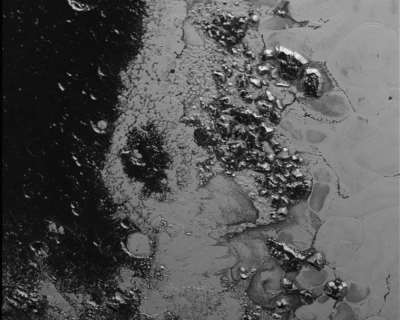Naming the frigid hills of faraway Pluto

Among the previous revelations under the category “All Things Pluto,” a region of the dwarf planet is being referred to as “Sputnik Planum” (Sputnik Plain) in honor of the Earth’s first artificial satellite, launched by the Soviets in 1957.
Memos document the reaction of President Dwight D. Eisenhower and top staffers to the launch. In one, found on the Eisenhower Presidential Library website, the president is told, "Soviet claims of scientific and technological superiority over the West and especially the U.S. have won greatly widened acceptance."
But it's all good now that we've reached the outer edge of the solar system, leaving the Russians in our cosmic dust. During a televised press conference July 17, Alan Stern, New Horizons' principal investigator, remarked, "Well, Sputnik was an explorer, too."
This most recent mountain range is similar to the Appalachian Mmountains in height, according to a NASA press release. On July 15, scientists spotted a more impressive range roughly approximating the Rockies. That range is being called the Norgay Mountains in honor of Nepalese mountaineer Tenzing Norgay, who was among the first to climb Mount Everest.
One region of the planet is being called the Tombaugh Regio (Tombaugh Region), named for Clyde Tombaugh, who discovered Pluto in 1930.
Researchers have been cautious to say they were "informally calling" various regions by name. In other words, these names are not finalized just yet. (See an explanation on how planetary features are named on the International Astronomical Union website.)
For the most part, Pluto and its five moons have names taken from Greek mythology. Here is the rundown:
Pluto: After the dwarf planet’s discovery in 1930, Venetia Burney, an 11-year-old English girl, was having breakfast with her family. Years later, in an interview with a NASA representative, she remembered that her grandfather wondered what the planet would be named. "Why not call it Pluto?" the girl remarked. Her grandfather was a librarian who had befriended astronomers. He passed the idea along. In mythology, Pluto rules the underworld.
Charon: Pluto’s biggest moon Charon was discovered in 1978 by astronomer James Christy, who proposed the name. Charon was a mythological ferryman of the dead who took souls across the river Acheron, one of five rivers flowing through Hades.
Nix and Hydra: Two small moons orbiting Pluto, Nix and Hydra, were discovered by NASA’s Hubble Space Telescope in 2005. The names are also part of the mythological lexicon. Nyx is the goddess of the night and mother of Charon. There was already an asteroid with the Greek name Nyx, so the International Astronomical Union changed Nyx to the Egyptian equivalent, Nix, according to NASA. In mythology, Hydra was a nine-headed monster.
Kerberos: Discovered in 2011 by the Hubble Space Telescope, Kerberos is named for the dog with multiple heads charged with guarding the entrance to the underworld.
Styx: Discovered in 2012, Styx is named for one of the rivers of the underworld.
Sources:
- NASA podcast transcript:The Girl Who Named Pluto.
- Encyclopedia Britannica online: Hydra.
- Mythology by Edith Hamilton (New American Library; 1969).
- The New York Times: Two of Pluto’s Moons Get Names from Greek Mythology’s Underworld (July 2, 2013).
- NASA: Pluto and its moons.
- National Archives: Eisenhower Sputnik Conference, Oct. 8, 1957.
- Eisenhower Presidential Library: Reaction to the Soviet Satellite, White House Office of the Staff Research Group, Oct. 16, 1957.
Related:
How planets and moons are named
U.S. probes reach throughout solar system
Spacecraft already offering insights about Pluto
Spacecraft to offer up-close look at Pluto
If you would like to comment, contact StudyHall.Rocks or like us on Facebook and tell us what you think.

